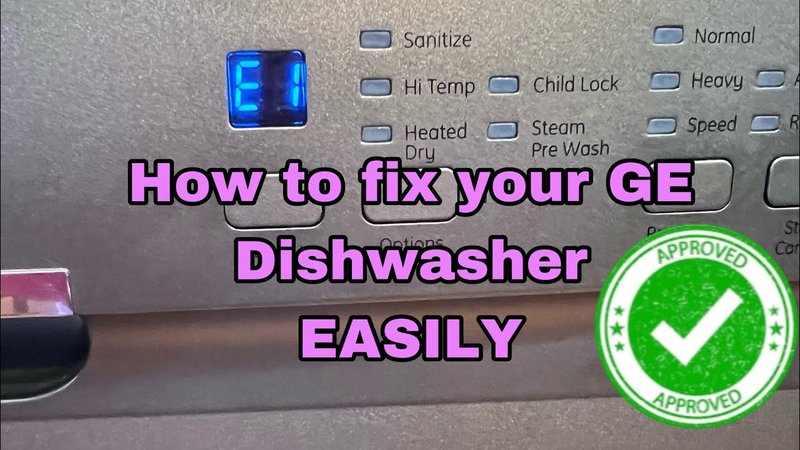
You might be wondering, what exactly is this OE error code? In the world of dishwashers, “OE” usually stands for “Overflow Error.” Imagine filling a bucket with water and forgetting to turn off the tap; eventually, water spills over. Similarly, this error indicates that there’s too much water in your dishwasher, or the machine thinks there is. It’s a safety feature designed to prevent any potential flooding in your kitchen. Resetting could be your first line of defense, but before you jump to conclusions, let’s understand the deeper details.
Understanding the OE Error Code
The OE error code essentially tells you that your dishwasher senses an overflow condition. So, what causes this? Well, think about the dishwasher as a water-tight box. If it’s incorrectly detecting the water level, it could be due to a faulty sensor or an actual overflow situation. Just like a misbehaving radar, the sensor might signal an overflow even when there isn’t one. Alternatively, the dishwasher’s internal systems could actually be filling up more water than necessary.
Now, let’s ponder some common causes of this overflow error. It might be as simple as a blocked drain hose. Imagine trying to drink a milkshake through a straw that’s bent or clogged—frustrating, right? Similarly, a blocked hose can’t let water out efficiently, leading to a backup. Another usual suspect is a malfunctioning water inlet valve, akin to your faucet not shutting off completely, hence allowing water to continuously trickle in. Sometimes, overly foamy soap can also trick the sensors into thinking there’s more water inside than there actually is.
Given these scenarios, a reset might not clear the underlying issue permanently. Much like rebooting your computer when it freezes, a reset can give you a temporary reprieve but won’t necessarily remove the cause of the crash. Therefore, understanding the root of the problem is crucial before relying solely on a reset solution.
Resetting Your GE Dishwasher: The First Step
Okay, so you’re ready to try resetting your dishwasher, and who wouldn’t be? It’s often the quickest and easiest action you can take. Here’s how you can go about it. First, make sure the dishwasher door is fully closed and latched. This step is vital because, like trying to start a car with the door open, it won’t quite work. Next, locate the “Start/Reset” button on your GE dishwasher’s control panel. Press this button and hold it for a few seconds. Some models might require just a quick press, but holding it down ensures you’ve got your bases covered.
Once you’ve pressed the reset button, wait for a couple of minutes. During this time, the dishwasher might drain the water, similar to flushing out a clogged sink, and then attempt to restart its cycle. If the error disappears, you might be in luck. But, if it returns, it signals that the problem could be more persistent than a quick fix.
If the reset doesn’t hold, don’t despair. It’s not uncommon for technical appliances to need a bit more TLC. You might need to dig deeper into possible physical obstructions or mechanical failures that could be causing the issue. For those who prefer to avoid getting their hands dirty, it might be time to call in a professional.
When Resetting Isn’t Enough
So, what if resetting doesn’t solve the problem? It’s time to roll up those sleeves and do some investigating. One potential area to examine is the dishwasher’s drain hose. Ensure it isn’t kinked, twisted, or obstructed by any foreign objects. You can liken this process to unblocking a vacuum cleaner hose; sometimes, the fix is as simple as removing a pesky sock.
Another likely culprit could be the float assembly, which helps regulate the water level inside your dishwasher. If this gets stuck or misaligned, it’s like a faulty traffic light causing chaos at an intersection. Inspect it for any signs of damage or obstruction and adjust it to ensure it moves freely.
If neither of these steps works, it might be time to consider the water inlet valve. This component controls the flow of water into your dishwasher, similar to how your gas pedal controls your car’s speed. A faulty valve might continuously allow water in, hence causing the overflow condition. Replacing it might require the services of a trained technician, but resolving this could keep that error code at bay.
Preventative Measures for the Future
Here’s the deal: prevention is always better than cure. Once you’ve resolved your OE error code, you might be wondering how to avoid a repeat performance. Regular maintenance is key. For starters, try running your dishwasher empty with a cup of white vinegar once a month. This acts like a mini-detox, keeping the interior clean and free from soap residue that can gum up the works.
Also, don’t forget to inspect and clean the dishwasher’s filters regularly. These act as barriers, catching food particles and debris, much like a net catching fish. If they get clogged, it can lead to water not draining properly and potentially triggering that pesky OE error.
Lastly, be mindful of the detergent you use. Too much or the wrong kind can lead to excess suds, tricking those sensors into thinking there’s an overflow when there isn’t. Use only dishwasher-specific detergents and stick to the recommended amounts.
In summary, while a reset can often be the first step in troubleshooting the OE error code on your GE dishwasher, understanding the root of the problem ensures a more permanent fix. Regular maintenance can stave off future errors and keep your dishwasher humming along smoothly. If things get too complex, don’t hesitate to seek professional help. After all, your dishwasher is an important ally in the kitchen, and keeping it happy will keep your household running efficiently.